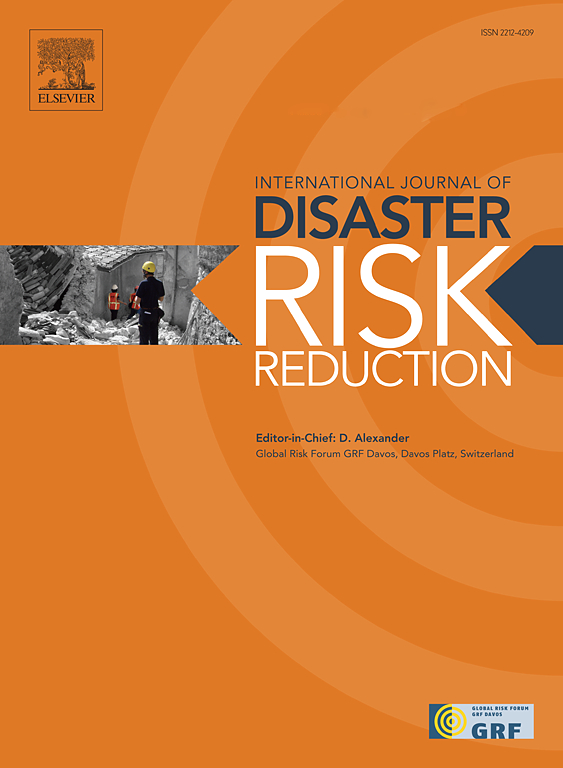Quantitative risk assessment for overtopping of earth-fill dams in Japan using machine learning algorithms
IF 4.2
1区 地球科学
Q1 GEOSCIENCES, MULTIDISCIPLINARY
International journal of disaster risk reduction
Pub Date : 2024-10-15
DOI:10.1016/j.ijdrr.2024.104892
引用次数: 0
Abstract
Earth-fill dams serve as crucial agricultural structures in Japan and act as buffers against flooding. However, their failure often tends to cause even greater downstream damage. Consequently, there is an urgent need for a quantitative assessment of the risks to earth-fill dams posed by disasters. The current detailed method of assessment is complicated, labour-intensive, and costly; hence, constructing risk surrogate models will greatly reduce the workload. This study employs two machine learning methods, GPR (Gaussian Process Regression) and XGBoost (eXtreme Gradient Boost), to develop surrogate models for assessing the damage cost and overtopping probability for 70 earth-fill dams in Okayama and Hiroshima prefectures, Japan. The predictive performance of each model was quantified by comparing the results against those of the detailed method. From the results, XGBoost demonstrates superior performance compared to GPR based on the comparison of coefficient of determination (R2) and root mean square error (RMSE). To clarify the extent to which the variables influence the XGBoost model, the SHapley Additive exPlanations (SHAP) algorithm was implemented. It offers an efficient and interpretable avenue for earth-fill dam risk assessments.
利用机器学习算法对日本堆土坝翻坝进行定量风险评估
填土大坝是日本重要的农业结构,也是洪水的缓冲区。然而,它们的溃坝往往会对下游造成更大的破坏。因此,迫切需要对灾害给土坝带来的风险进行定量评估。目前的详细评估方法复杂、劳动密集且成本高昂,因此,构建风险替代模型将大大减少工作量。本研究采用 GPR(高斯过程回归)和 XGBoost(极端梯度提升)两种机器学习方法,为日本冈山县和广岛县的 70 座土填坝开发了用于评估损害成本和翻坝概率的代用模型。通过与详细方法的结果进行比较,对每个模型的预测性能进行了量化。从结果来看,根据判定系数 (R2) 和均方根误差 (RMSE) 的比较,XGBoost 的性能优于 GPR。为了明确变量对 XGBoost 模型的影响程度,采用了 SHapley Additive exPlanations(SHAP)算法。该算法为土坝风险评估提供了一个高效且可解释的途径。
本文章由计算机程序翻译,如有差异,请以英文原文为准。
求助全文
约1分钟内获得全文
求助全文
来源期刊

International journal of disaster risk reduction
GEOSCIENCES, MULTIDISCIPLINARYMETEOROLOGY-METEOROLOGY & ATMOSPHERIC SCIENCES
CiteScore
8.70
自引率
18.00%
发文量
688
审稿时长
79 days
期刊介绍:
The International Journal of Disaster Risk Reduction (IJDRR) is the journal for researchers, policymakers and practitioners across diverse disciplines: earth sciences and their implications; environmental sciences; engineering; urban studies; geography; and the social sciences. IJDRR publishes fundamental and applied research, critical reviews, policy papers and case studies with a particular focus on multi-disciplinary research that aims to reduce the impact of natural, technological, social and intentional disasters. IJDRR stimulates exchange of ideas and knowledge transfer on disaster research, mitigation, adaptation, prevention and risk reduction at all geographical scales: local, national and international.
Key topics:-
-multifaceted disaster and cascading disasters
-the development of disaster risk reduction strategies and techniques
-discussion and development of effective warning and educational systems for risk management at all levels
-disasters associated with climate change
-vulnerability analysis and vulnerability trends
-emerging risks
-resilience against disasters.
The journal particularly encourages papers that approach risk from a multi-disciplinary perspective.
 求助内容:
求助内容: 应助结果提醒方式:
应助结果提醒方式:


